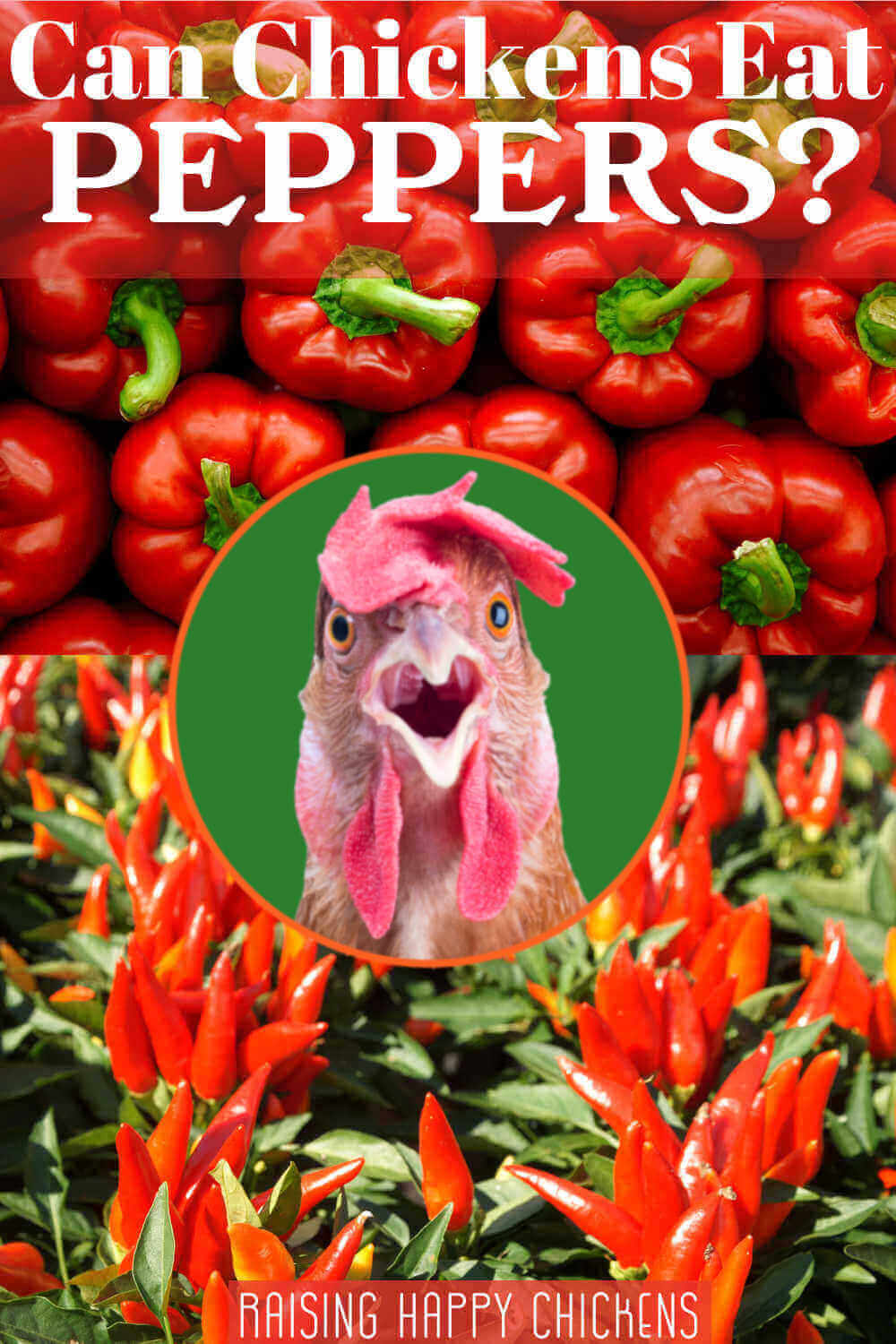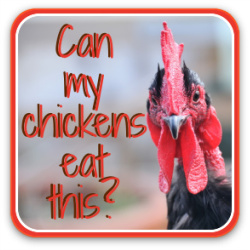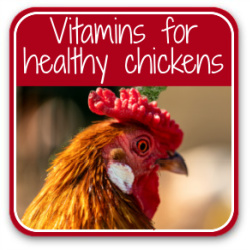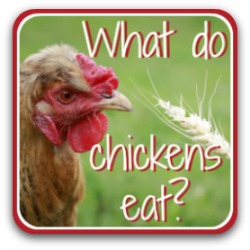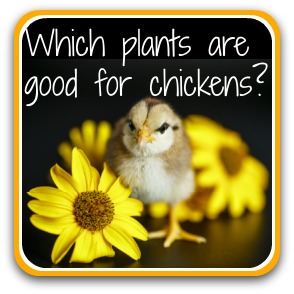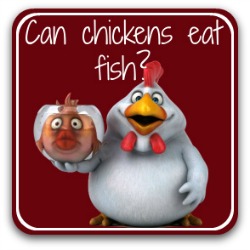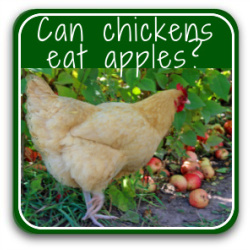- Home
- Can chickens eat ...?
- Peppers
Can chickens eat peppers?
Are bell peppers good to feed to chickens? What about hot peppers?
Does colour matter? And what's the evidence that peppers can help – or harm – a chicken's health?
In this article, based on research and peer-reviewed studies, we'll discover...
* what nutrition is contained in bell and hot peppers
* what those nutritional values give chickens
* which colour pepper is best
* which type of hot pepper is most effective
* whether there's any part of the pepper that's not good
*what effect, if any, peppers have on eggs
* how best to feed peppers to chickens
* And, as a bonus, there's a chicken treat recipe based on the researched data between poultry and peppers!
Can chickens eat peppers? How to use this article.
This is a long and detailed article. Use these links to jump to a particular section, or carry on reading for all the information.
Bell pepper nutrition: the facts.
For more detailed, research-based information about the effects of nutrients on chickens, see my article about the impact of vitamins and minerals on chicken health.
Technically a berry rather than a vegetable, bell peppers are known to be a rich source of nutrients for humans. But what about their value for chickens?
Fresh bell peppers: super-nutrients.
Fresh, raw bell peppers contain no fat, a lot of water, and exceptionally high amounts of...
- Vitamin A: essential for boosting a chicken's immune system, the healthy regeneration of cells, and dealing with extreme temperatures and moulting (1, 2, 3)
- Vitamin C: bell peppers – particularly red peppers – are one of the richest dietary sources of this vitamin(1, 2, 3). Vitamin 'C' is an established anti-oxidant, protecting against cell damage and responsible for supporting the chicken's immune system.
- Vitamin B6 and B9 (folate): present particularly in red peppers. These vitamins help chickens absorb proteins and are critical for the development of healthy bones and feathers.
Fresh bell peppers: other nutrients.
In addition to the super-charging of those nutrients in bell peppers, they also contain good amounts of...
- Vitamin E: an antioxidant which helps maintain healthy cell growth and can help protect against (but does not cure) diseases such as e.coli and coccidiosis
- Vitamin K1: which ensures blood clotting – useful in the event of predator attacks
What bell peppers don't contain...
...is capsaicin, the active chemical which makes chilli peppers hot. Bell peppers range from green, which is the most bitter, through yellow and orange to red, the sweetest.

So – can chickens eat bell peppers?
The simple answer is "absolutely yes, they can!".
Given the massive vitamin and mineral content of bell peppers described above, it's hardly surprising that research studies have specifically shown that...
- the very high levels of Vitamin A in particular had a positive impact on hens who were heat stressed, and increased their laying rate and immune function(4)
- Vitamin A levels in chickens fed a bell pepper supplement also increased the weight of eggs laid(4)
- the high levels of Vitamin C helped increase their intake of iron, critical for maintaining general organ function and egg nutritional quality.(3, 4)

Which type and colour of bell pepper is best for chicken health?
Use fresh, red bell peppers for optimum health effects!
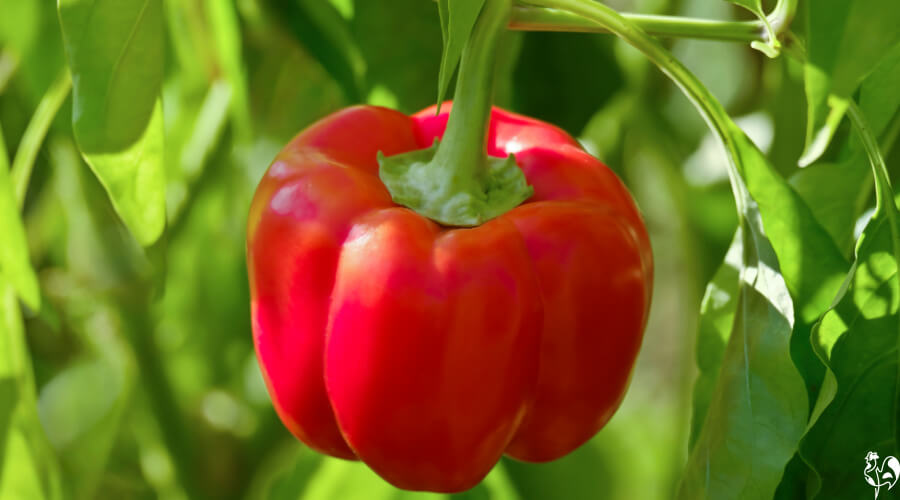 My red peppers are grown away from my chickens.
My red peppers are grown away from my chickens.- Red bell peppers beat their green, orange and yellow cousins by a long way. They have the highest content of Vitamin A(4, 5, 6)
- Red bell peppers also contain 11 times more antioxidants – particularly carotenoids – than others(5, 6)...
- ...and twice as much Vitamin C(4, 5, 6).

Hot pepper nutrition: the facts.
There are claims all over the internet that hot (UK chilli; US chili) peppers can cure everything from heart disease in humans to a worm infestation in chickens.
But what's the real story?
Hot peppers and vitamins.
Both fresh hot and fresh bell peppers have excellent nutritional benefits in terms of vitamins – but there are some differences.(5, 7, 8)
- Vitamin A: red bell peppers have 166% more Vitamin A than hot peppers
- Vitamin C: hot red peppers come out best here, with 90% more Vitamin C than bell peppers
- Vitamin B complex: both have roughly equal amounts of the B Vitamins, including folate
- Vitamin K: they also contain similar amounts of Vitamin K.
Hot peppers and minerals.
This is where differences show, and perhaps why hot rather than bell peppers have been the subject of a good deal of active research in terms of their benefits for chickens.
- Calcium: hot peppers contain a massive 157% more calcium than bell peppers.
- Iron: hot peppers have 179% more iron than bells. Chickens need iron to maintain general organ health. A lack can result in anaemia, a decrease in egg production, and a poor hatchability rate of fertile eggs.
- Potassium: hot peppers have 61% more than even the red bell pepper.
- Lutein: red bell peppers have virtually no lutein (although green bells do), whereas red hot (chilli) peppers have around 725 microgrammes. Lutein is responsible for improving the deep colour of egg yolks(9).
What makes peppers hot?
The compound that really makes hot peppers stand apart from their bell cousins is Capsaicin.
It's what gives peppers their red colour, makes them hot and, in humans, can cause burning of the skin and – depending on the heat strength – irritation of the mouth, stomach and intestines, and difficulty in breathing.
In chickens, however, it's a very different story.
Because chickens (and birds in general) cannot taste Capsaicin. And, being indifferent to the effects of even the hottest strength, they benefit only from its health advantages.(10, 11, 12)

So – can chickens eat hot peppers?
The simple answer is "they can – and they should!".
Capsaicin is not only what makes peppers hot. It's a powerful antioxidant, critical in chickens for strong growth and development, resistance to stress and boosting of the immune system.
Peer-reviewed research into the effect of hot red peppers on chickens found they:
- improve the fat (lipid) content in their blood, lowering total cholesterol levels(12)
- there is disagreement over whether hot peppers provide a credible alternative to antibiotics – it's thought that they are, but more research is needed to provide hard evidence(13).
There was also a clear impact on eggs, which...
- were heavier(14)
- had an improved yolk colour, changing from pale yellow to dark orange(4, 12, 14, 15)
- continued to have a darker yolk colour up to eight days after the peppers were withdrawn from their feed.(14)

Which type and colour of hot pepper is best for chicken health?
Most research studies use peppers from the Capsicum frutescens group. The most well known of these is the Tabasco pepper.
The Tabasco plant is a small bush which can be easily grown in pots. It reaches just two to three feet high, so it's ideal for a sunny patio or small greenhouse.
I grow mine in pots on my outside kitchen terrace.
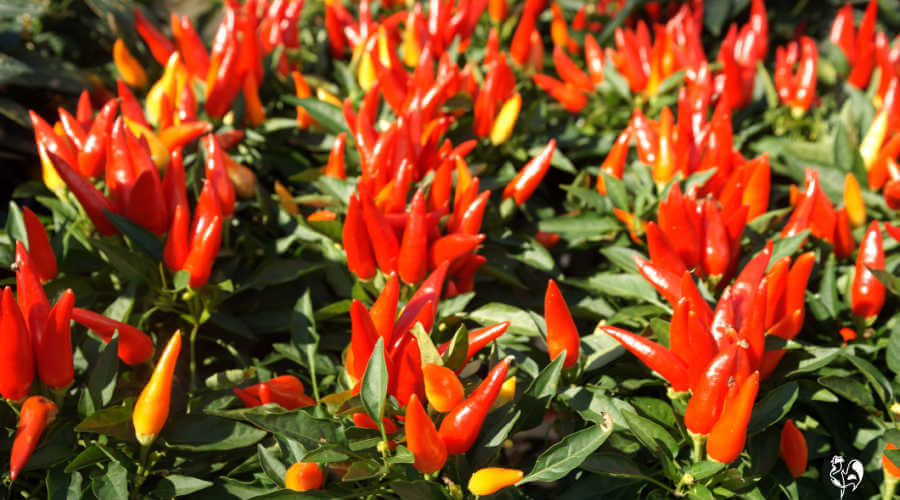 My Tabasco plants: good for my chickens, good for me!
My Tabasco plants: good for my chickens, good for me!- Unlike bell peppers, the peppers themselves grow upwards rather than hanging down. Leaving them on the plant, they will slowly turn from green to yellow and then red.
- They're a medium hot pepper, scoring somewhere between 30,000 and 50,000 units on the "Scoville heat scale".
- As a comparison, bell peppers score zero on that scale, and the Carolina Reaper pepper (which I also grow) scores around 2.2 million units!
- All those units are meaningless to chickens, though, since they don't have heat receptors and so can't feel the effects of even the hottest of peppers.
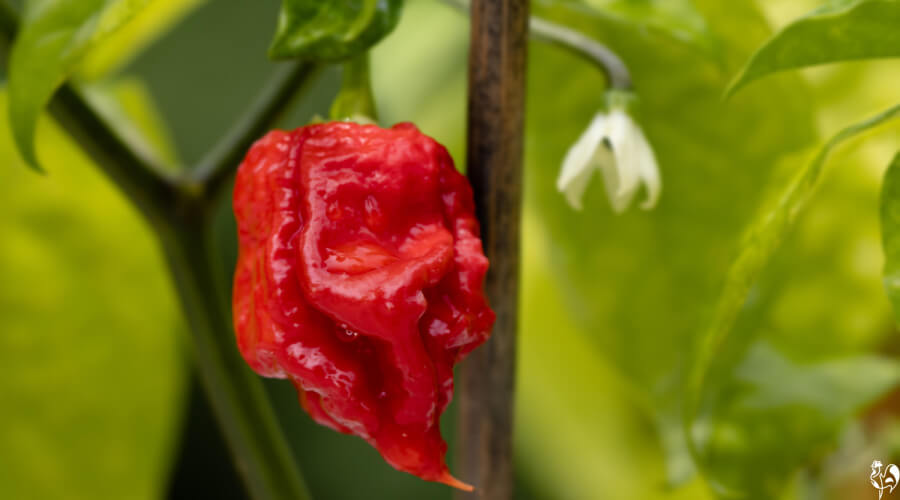 One of my ripe California Reaper peppers.
One of my ripe California Reaper peppers.
Any negatives about feeding bell or hot peppers to chickens?
All peppers, including both bell and hot peppers are, like tomatoes, members of the Solanaceae, or deadly nightshade, family.
The Latin name comes from the fact that the plants contain solanine. Solanine is poisonous to chickens.
So while the ripe peppers are a great advantage to chicken health, the plants themselves – the roots, vines and leaves – are a real issue.
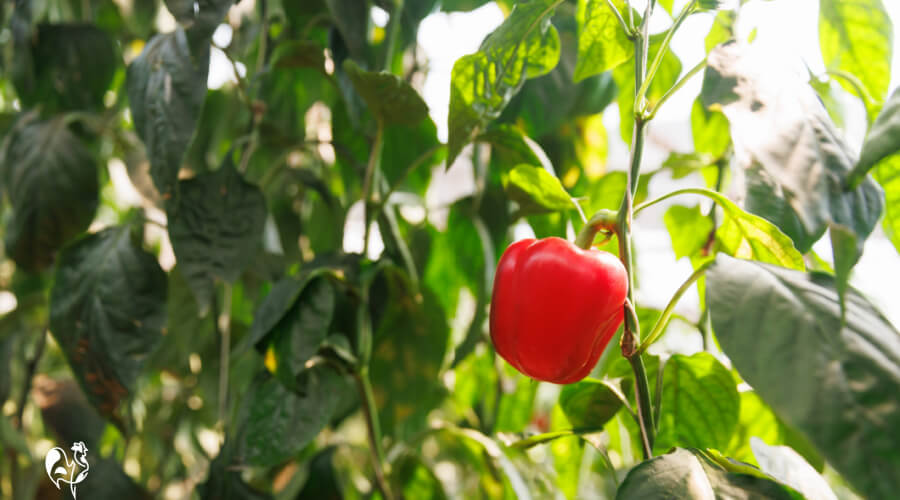 Feed chickens the peppers but keep them off the plants!
Feed chickens the peppers but keep them off the plants!There's a simple answer to this: feed your chickens the peppers, but if you're growing your own plants (which I highly recommend!), grow them somewhere well away from your chickens' run.
Or, if your chickens free range, make sure the plants are fenced off so that inquisitive beaks don't put themselves in danger.

How to use peppers as part of your chickens' diet.
Bell peppers as a chicken treat.
- Always use fresh, red bell peppers. Canned or pre-roasted peppers from the deli counter will already have lost up to 25% of their Vitamin C content.
- Where possible, try growing your own. They're easily raised from seed, and you're then sure that they are free from chemicals and growth hormones.
- The easiest way to use bell peppers is simply to cut them in half, or in smaller pieces, and set the chickens loose on them!
- For added benefits, include them when you ferment chicken feed.
Hot peppers in the chicken diet.
- The best way to offer hot peppers to your flock is in the form of flakes.
- The type of hot pepper doesn't really matter, although if you prefer to follow the research studies precisely, use fresh Tabasco peppers.
- Do not use the bottled Tabasco sauce. It contains too much salt, and a liquid added to your chicken feed is likely to create mould.
- So again, where possible use fresh red peppers and dry them yourself. If you don't have a dehydrator, do as the Italians do – just hang the peppers in a dry place and leave them!
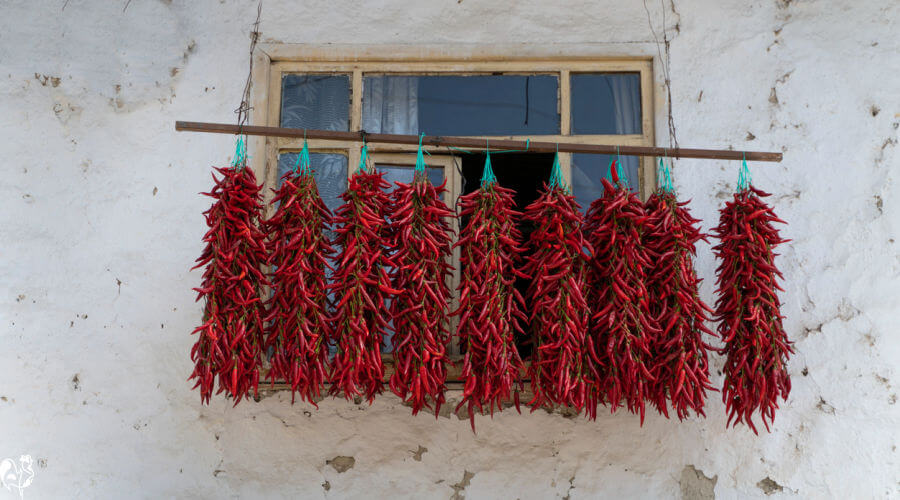
- Although they're not as potent, hot pepper flakes from the spices cabinet will work as well, if you're not in a position to grow your own or buy fresh.
- The research studies recommend adding no more than 0.5% of hot pepper flakes to chicken feed for optimum results.
- There's no need to be that precise for your own chickens to benefit. I mix in two teaspoons of hot flakes when I fill their automatic feeder hopper, every few days.

An easy stuffed bell pepper treat recipe to keep your chickens in top condition.
Chickens will love to eat these healthy stuffed bell pepper treats. They offer a fun way to add a balanced variety of textures and nutrients to the chicken diet.
Remember to remove any uneaten food before roosting time, to keep the environment clean and avoid rodent infestations.
And as always, remember that all treats should be given in moderation and should not replace the flock's normal chicken feed.
Poultry Pepper Pleasers: ingredients.
Allow one large bell pepper for every four chickens. Adjust the ingredients accordingly if making more.
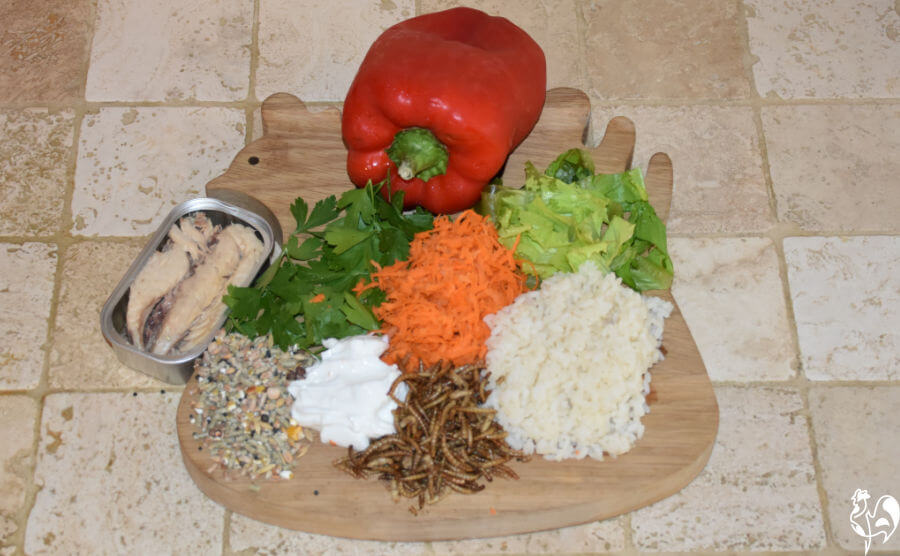
- 1 large red bell pepper
- 1 small tin fish (mackerel or sardines are a good choice, but make sure they are in oil, not brine)
- 1/4 cup rice
- 1/4 cup chopped leafy greens (spinach, kale, or lettuce)
- 1/4 cup uncooked, finely grated carrots
- 1/4 cup chopped fresh herbs (parsley is best but basil or mint are also good)
- 2 tablespoons wild bird food (or your own chicken feed)
- 1 tablespoon mealworms or other dried insects (optional)
- 1 tablespoon plain yogurt (fat free Greek yoghurt is best; do not use sweetened or flavoured yoghurts)
- 1 teaspoon olive oil.
Poultry Pepper Pleasers: instructions.
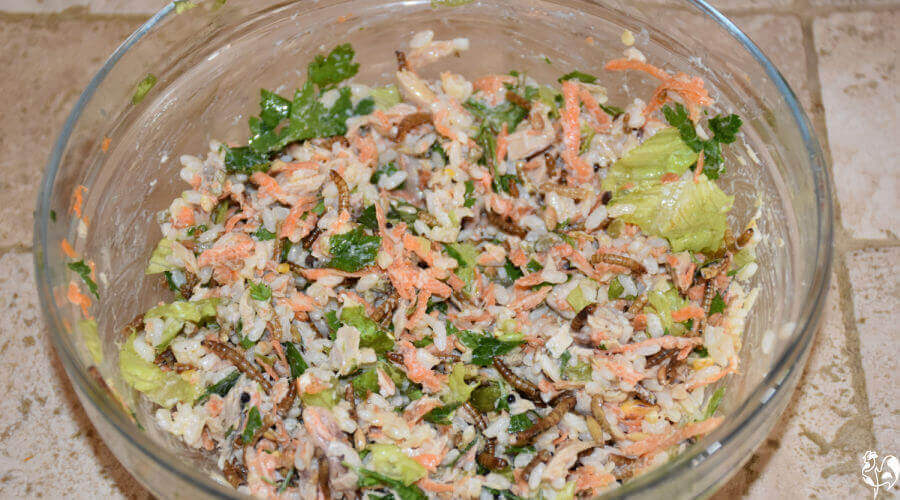
- Preheat the oven to 175ºC (350°F; gas mark 4).
- Cook the rice and put aside to cool.
- Cut the red bell peppers in half. Remove the membranes and stalk and discard. Put the seeds in a bowl.
- Add into the bowl the fish, cooked rice, chopped leafy greens, grated carrots, chopped herbs, bird food and mealworms (if using).
- Mix in the plain yogurt and olive oil to bind the ingredients together and add moisture.
- Stuff the red bell peppers with the fish and vegetable mixture, pressing it down gently as you fill them.
- Place the stuffed peppers in a greased baking dish.
- Cover the baking dish with aluminium foil and bake for 20 minutes, or until the peppers are tender.
- Allow the stuffed peppers to cool before offering them to your chickens.
- Place in the run, and watch your chickens enjoy this delicious, nutritious treat.
These stuffed peppers will freeze well for up to three months.
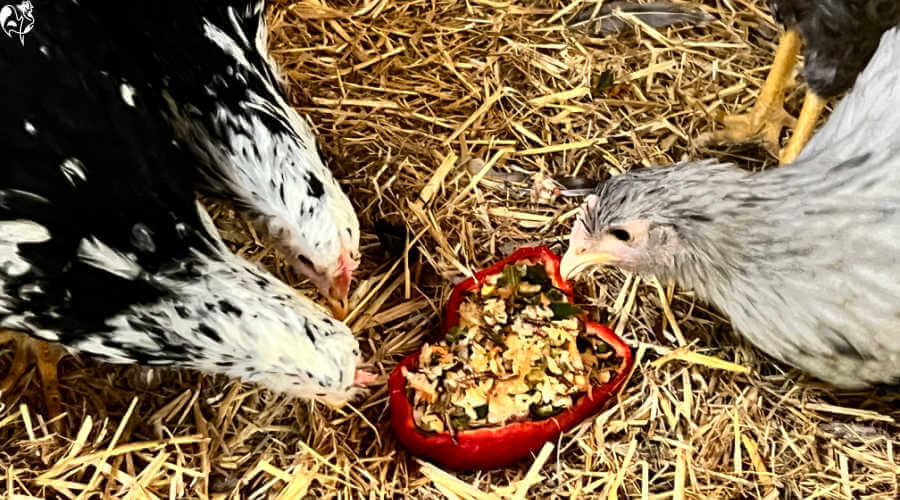 Three of my hens tuck into their Pepper Pleaser
Three of my hens tuck into their Pepper Pleaser
Frequently Asked Questions about chickens and peppers.
Can chickens eat green peppers?
Can chickens eat green peppers?
Is spicy food a de-wormer for chickens?
Is spicy food a de-wormer for chickens?
No, there's absolutely no evidence for this.
Some chicken keepers may tell you they feed their chickens hot peppers and they have never had worms so they must be a de-wormer.
That's a non-sequitor. It's like saying all chickens have wings. That penguin has wings. So that penguin must be a chicken.
Can chickens eat cayenne pepper?
Can chickens eat cayenne pepper?
Can chickens eat black pepper?
Can chickens eat black pepper?
Yes.
However, research studies about whether chickens can eat black pepper found that it causes a reduction in eggshell strength, and an increase in the level of triglycerides in the bloodstream.(16)
So it's better to feed red pepper flakes.
If chickens eat peppers, will their eggs taste strange?
If chickens eat peppers, will their eggs taste strange?
No, chickens can eat peppers without adding taste to their eggs as long as the peppers are fed in moderation.
There is no evidence anywhere that eating either bell or hot peppers makes eggs taste differently. The evidence is that hot peppers in particular improve the colour of egg yolk, and potentially add weight.

Related articles you may find useful.

Sources.
A lot of "facts" you'll find on the internet are often people's individual views, based on inaccurate information repeated from poor quality sources.
The information I provide in this article and others is based not just on my own experience, but on evidenced facts from scientific, peer-reviewed research and books from highly respected and experienced poultry keepers such as Gail Damerow.
Some of the trusted sources I have used in this article are these.
1. U.S. Department of Agriculture: Peppers: sweet, red, raw. nutrition. Pub. Food Data Central, 2019.
2. Torrens, K: Top 5 health benefits of peppers. Pub. BBC Good Food Guide, 2023.
3. Arnarson, A: Bell Peppers 101: Nutrition Facts and Health Benefits. Pub. Healthline, 2023.
4. Lin H., et al: Effect of dietary supplementation levels of vitamin A on the egg production and immune responses of heat-stressed laying hens. Pub. Journal of Poultry Science, 2002.
5. Brody, B: Pepper Power: Nutrition and Other Benefits. Pub. WebMD, 2022.
6. The Health Benefits of Red Bell Peppers. Pub. The Cleveland Clinic, 2023.
7. Arnarson, A: Chili Peppers 101: Nutrition Facts and Health Effects. Pub. Healthline, 2023.
8. U.S. Department of Agriculture: Food Data Central. Pub. 2023.
9. Wen et al: Dietary Supplementation with Microencapsulated Lutein Improves Yolk Color and Lutein Content in Fresh and Cooked Eggs of Laying Hens. Pub. Journal of Poultry Science, 2021.
10. Herrero-Encinas, J: Impact of Dietary Supplementation of Spice Extracts on Growth Performance, Nutrient Digestibility and Antioxidant Response in Broiler Chickens. Pub. National Center for Biotechnology Information, 2023.
11. Jordt, S.E., and Julius, S: Molecular basis for species-specific sensitivity to "hot" chili peppers. Pub. National Center for Biotechnology Information, 2002.
12. Marić , M., et al: Chili Pepper and its Influence on Productive Results and Health Parameters of Broiler Chickens. Pub. Journal of Agronomy, Technology and Engineering Management, 2021.
13. El Hack, M. E., et al: Hot red pepper powder as a safe alternative to antibiotics in organic poultry feed: an updated review. Pub. Journal of Poultry Science, 2022.
14. Li, H., et al: Effect of Red Pepper (Capsicum frutescens) Powder or Red Pepper Pigment on the Performance and Egg Yolk Color of Laying Hens. Pub. Journal of Asian-Australasian Animal Science, 2012.
15. Blount, J. D., et al: Why egg yolk is yellow. Pub. Trends in Ecology and Evolution, 2000.
16. Melo, R.D., et al: Black pepper (Piper nigrum) in diets for laying hens on performance, egg quality and blood biochemical parameters. Pub. Journal of Animal Science, 2016.
- Home
- Can chickens eat ...?
- Peppers
